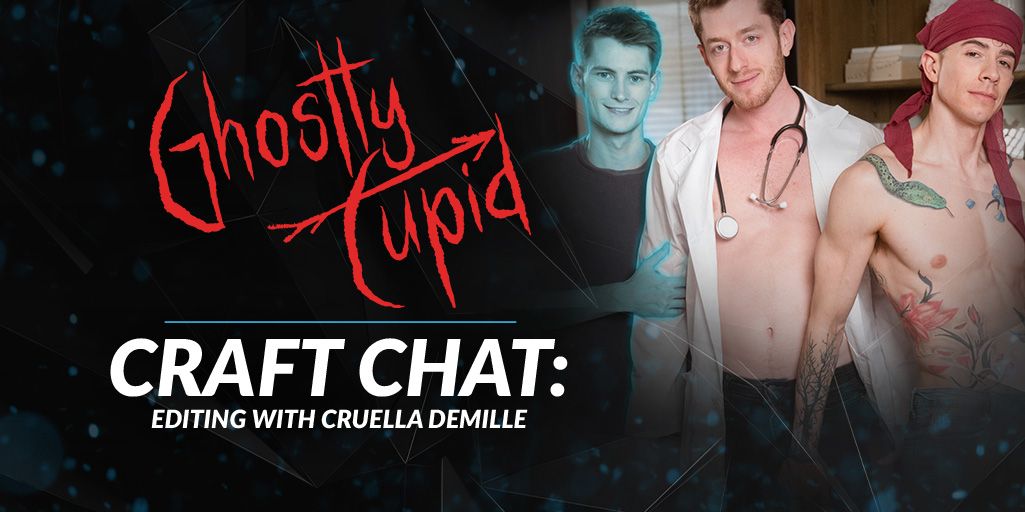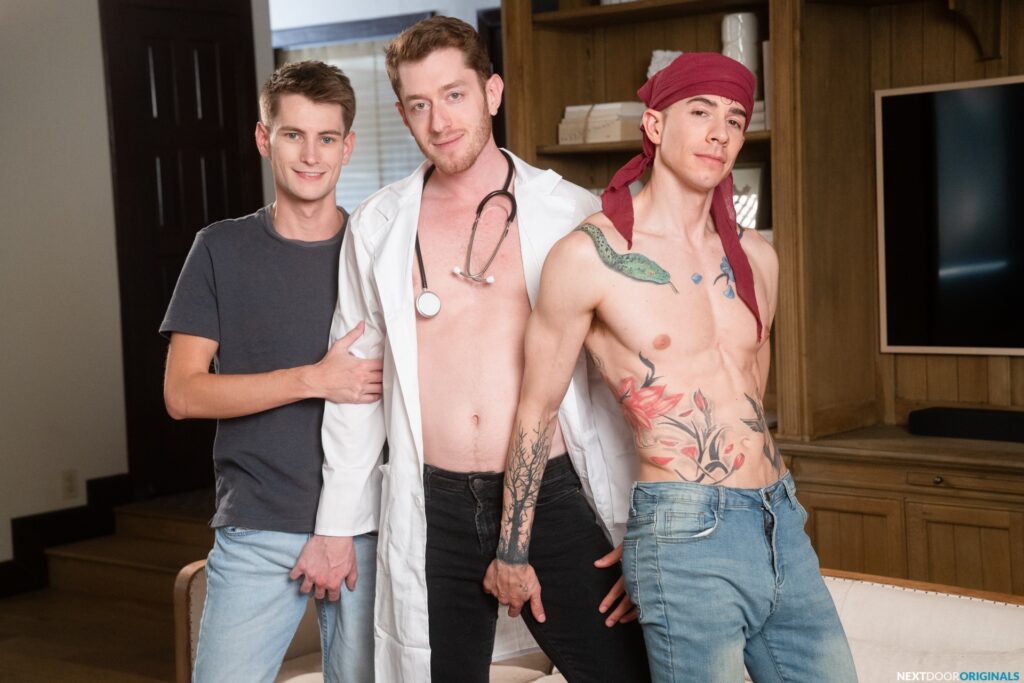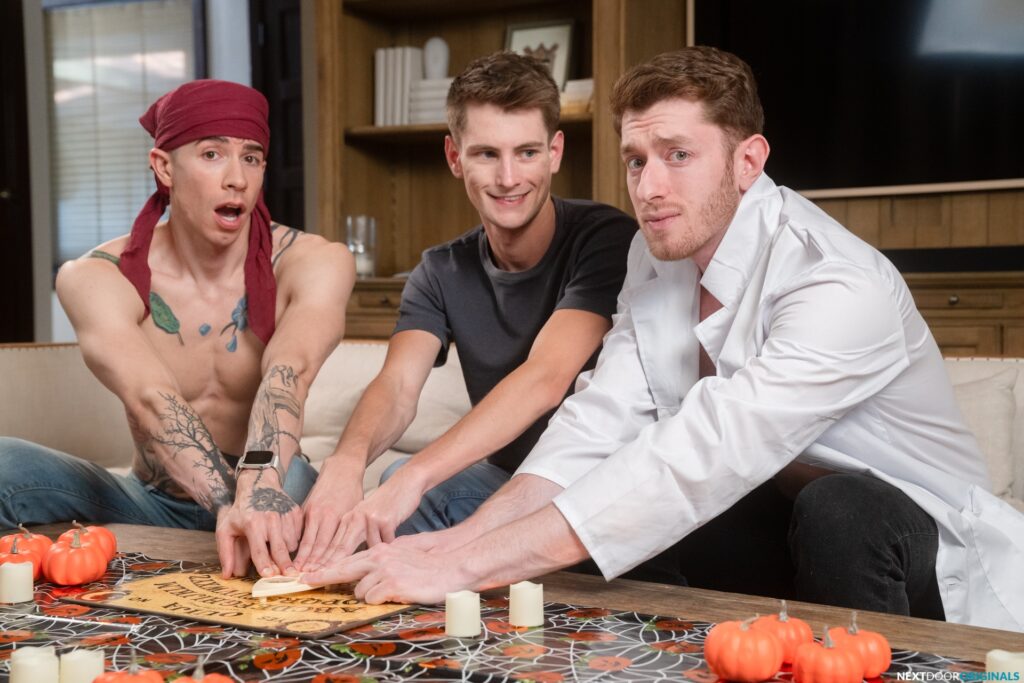
Next Door Studios’ is excited to spook and scintillate in their upcoming Halloween offering, “Ghostly Cupid.” The scene, written and directed by Micah Martinez, stars Vincent O’Reilly, Jake Klerin, and Trevor Harris. It’s hauntingly hot thanks to the featured talent, but also due to the hard work of “Ghostly Cupid’s” video editor, Cruella DeMille.
We sat down with DeMille to discuss the craft of great editing, and her vision for the scene.
Please tell us about the scene.
This scene’s packed with something for everyone, not just Halloween fans. Vincent, Trevor, and Jake deliver performances that swing from laugh-out-loud moments to gripping jump scares that keep you hooked. Micah nailed it with a script that’s as playful, dark and spooky as it is captivating, and he brought that vibe straight to the set. For an editor, this was a dream—no digging needed. The gold was already there, just waiting to hit the screen.
Please tell us about your approach to the process.
From day one, we knew we had to bring a ghost to life. Once we nailed down the VFX tech, it was all about dialing in the look. Inspired by the original “Ghostbusters,” I wanted a hint of that classic Proton Beam style woven into the design. We also played around with Trevor’s character’s “ghost aura,” testing out five designs until we had the winner. He might not look like The Mean Green Ghost, but his roots definitely trace back there.
What was your main goal or vision for the atmosphere of this scene?
The script served up playful moments, while the footage delivered jump scares and practical effects. Our mission? Fuse those two worlds seamlessly. It was a challenge, but we were all in to strike that perfect balance between laughs and chills.
What mood were you aiming to achieve?
We really wanted this to be fun and light and sexy with moments of Halloween spookiness peppered in.
How did you choose the sound effects for the scene? Were there any specific sounds you felt were essential?
For any true horror or Halloween fan, this part was mission-critical: nailing the sound design. We had to amplify the spooky moments, especially those silent scenes that rely on mood alone. Our goal? Keep it true to modern horror SFX—no cheesy gimmicks. We went heavy on LFEs, layered with contemporary sci-fi and eerie voice effects. Trevor’s character has a killer ‘teleport’ move, and the sound is unmistakable. The moment that teleport SFX hits, you know he’s lurking, even before he steps into frame. It’s the cue that makes you feel him creeping closer, setting up the reveal.
Did you create any custom sound effects, or did you use a library?
We used some production SFX from our secret ASGmax Vault & some SFX from a library. We didn’t create anything from scratch but we multilayered a ton of SFX within a scene and it created some very cool layered soundscapes.
If you used a library, what were some of your go-to sources?
Soundsnap is our secret weapon. It’s packed with top-notch sci-fi hits, eerie risers, ominous gongs, unsettling metal squeals—you name it. If it sounds weird or spine-chilling, Soundsnap’s got it.
How do you think the sound effects contribute to the overall tension or mood of the scene?
SFX is the heartbeat of any horror flick, pulsing alongside the music to drive the tension and set the mood. It’s what keeps the audience riding those highs and lows, the engine that powers every twist and turn. For us, SFX were essential to the edit and the scene’s punch. They’re what made the whole thing hit hard.
What special effects did you incorporate, and how did you decide which ones to use?
To get that Proton Beam look in Trevor’s ghost, we went all in with VFX—green screen keying, rotoscoping, 3D camera projection and layered animations. Early versions had effects that were bold and bright, with colors that could rival The Mean Green Ghost himself. Eventually, we dialed it back. Micah had his own vision, drawing from an ASGmax scene called “The Lost Soul,” where he wanted Trevor to have an animated, textured look. That detail made it into the final VFX design.
Then came Trevor’s signature ‘blipping’ teleport. I took inspiration from X-Men’s Nightcrawler—his ability to vanish in a plume of smoke is iconic. But Trevor’s ghost needed a sharper, sci-fi edge. Instead of organic effects like smoke or dust, we gave him a ‘digital’ spectral dust effect, where he blips in and out as a stream of particles. The digital feel paired perfectly with his sound design, creating a teleport that’s distinct and sharp.
Some of the scenes have objects that move seemingly all by themselves, and to do that, we employed a touch of old school Hollywood magic – practical effects. We blended practical effects with some digital VFX painting to put as much realism into the scene as possible.
How do you think the special effects enhanced the storytelling in this Halloween scene?
These effects were crucial for bringing Micah’s vision to life. We set out to build a world where the impossible feels real, flipping reality on its head and breaking all the rules of physics. The result? A haunting, spine-tingling atmosphere that’s just right for a Halloween special.
Can you describe your approach to color grading for this scene? Did you use any specific color palettes or techniques to evoke a spooky atmosphere?
We stuck to classic Hollywood horror vibes, dialing in cool, neutral tones to keep things cold and distant as the ghostly mayhem unfolds. But as the scene heats up, so does the color—bringing in warmth not only for the intensity of the moment but to show our characters letting their guard down around the ghost. It’s a twist that makes him seem more inviting, or maybe just shows how easily Vincent and Jake’s characters get reeled in.
How important is color grading in setting the tone for a Halloween-themed scene?
Just like the SFX, the color grade is essential for setting the tone, giving viewers those subtle emotional cues that get under the skin. In Halloween and horror films, it’s all about pushing boundaries with colors that feel unnatural and bizarre—dialing up that unsettling, almost surreal vibe. Think of the 90s cross-processing style in Rob Zombie’s House of 1000 Corpses; those surreal, stylized moments leave you on edge.
How closely did you collaborate with the director and other team members during the editing process?
I’ve been speaking as ‘we’ because this project was a total team effort. Every piece—from VFX and SFX to color and music—was a product of constant collaboration, testing, and input. Countless Slack messages, VFX reviews, and adjustments were all part of making sure we hit the vision spot-on. Micah Martinez and Jeremy Babcock were instrumental in post-production, pushing the scene to its best. That teamwork didn’t just nail the final look and feel—it made the whole process a blast.
What are some of the final touches you made that you feel really elevated the scene?
It was the VFX and SFX in those last stages that truly leveled it up, taking the intensity and impact to where it needed to be.
If you had to pick one element (sound, special effects, or color) that you think stands out the most, what would it be and why?
Sure, the VFX grabs attention, but it’s the sound effects and music choices that make the scene unforgettable. They build atmosphere, set the tension, and signal when the ghost is about to show up. Together, they bring the story to life in a way that’s powerful and irreplaceable—without them, the scene just wouldn’t hit the same.
Make your mischief night (Wednesday, October 30, 2024) extra mischievous by streaming “Ghostly Cupid”— only on ASGmax.

